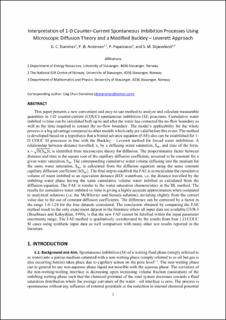| dc.contributor.author | Standnes, Dag Chun | |
| dc.contributor.author | Andersen, Pål Østebø | |
| dc.contributor.author | Papatzacos, Paul Georg | |
| dc.contributor.author | Skjæveland, Svein Magne | |
| dc.date.accessioned | 2020-04-16T13:27:13Z | |
| dc.date.available | 2020-04-16T13:27:13Z | |
| dc.date.created | 2020-04-11T13:05:47Z | |
| dc.date.issued | 2020-04 | |
| dc.identifier.citation | Standnes, D.C., Andersen, P.Ø., Papatzacos, P. et al. (2020) Interpretation of 1-D Counter-Current Spontaneous Imbibition Processes Using Microscopic Diffusion Theory and a Modified Buckley – Leverett Approach. Energy & Fuels, | en_US |
| dc.identifier.issn | 0887-0624 | |
| dc.identifier.uri | https://hdl.handle.net/11250/2651345 | |
| dc.description.abstract | This paper presents a new convenient and easy-to-use method to analyze and calculate measurable quantities in 1-D counter-current (COUC) spontaneous imbibition (SI) processes. Cumulative water imbibed vs time can be calculated both up to and after the water has contacted the no-flow boundary as well as the time required to contact the no-flow boundary. The model’s applicability for the whole process is a big advantage compared to other models which only are valid before this event. The method is developed based on a hypothesis that a frontal advance equation (FAE) also can be established for 1-D COUC SI processes in line with the Buckley – Leverett method for forced water imbibition. A relationship between distance travelled, x, by a diffusing water saturation, S_w, and time of the form, x ~ √(D(S_w)t), is identified from microscopic theory for diffusion. The proportionality factor between distance and time is the square root of the capillary diffusion coefficient, assumed to be constant for a given water saturation, S_w. The corresponding cumulative water volume diffusing into the medium for the same water saturation, S_w, is calculated from the diffusion equation using the same constant capillary diffusion coefficient D(S_w ). The final step to establish the FAE is to recalculate the cumulative volume of water imbibed to an equivalent distance (ED) waterfront, i.e. the distance travelled by the imbibing water phase having the same cumulative volume water imbibed as calculated from the diffusion equation. The FAE is similar to the water saturation characteristics in the BL method. The results for cumulative water imbibed vs. time is giving a highly accurate approximation when compared to analytical solutions (i.e. the McWhorter and Sunada solution), deviating slightly from the correct value due to the use of constant diffusion coefficients. The difference can be corrected by a factor in the range 1.0-1.24 for the four datasets considered. The conclusion obtained by comparing the FAE method result to the only experiment dataset in the literature where all input data are available GVB-3 (Bourbiaux and Kalaydjian, 1990), is that the new FAE cannot be falsified within the input parameter uncertainty range. The FAE method is qualitatively corroborated by the results from four 1-D COUC SI cases using synthetic input data as well comparison with many other test results reported in the literature. | en_US |
| dc.language.iso | eng | en_US |
| dc.publisher | American Chemical Society | en_US |
| dc.title | Interpretation of 1-D Counter-Current Spontaneous Imbibition Processes Using Microscopic Diffusion Theory and a Modified Buckley – Leverett Approach | en_US |
| dc.type | Peer reviewed | en_US |
| dc.type | Journal article | en_US |
| dc.description.version | acceptedVersion | en_US |
| dc.rights.holder | © 2020 American Chemical Society | en_US |
| dc.subject.nsi | VDP::Teknologi: 500::Berg‑ og petroleumsfag: 510 | en_US |
| dc.source.journal | Energy & Fuels | en_US |
| dc.identifier.doi | 10.1021/acs.energyfuels.0c01109 | |
| dc.identifier.cristin | 1805852 | |
| dc.relation.project | Norges forskningsråd: 230303 | en_US |
| cristin.ispublished | false | |
| cristin.fulltext | postprint | |
| cristin.qualitycode | 2 | |
